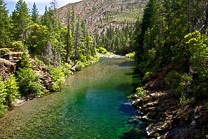Watershed
Stories from the Smith River Alliance NewsletterRestoring The Wild & Working Landscape of Upper Tryon Creek
Teaming with Productivity
When most people think of the Smith River, they think of the wild and scenic vistas along Highway 199 where majestic blue green waters flow over serpentine rocks or views of the river from Jedediah Smith State Park with a backdrop of old growth redwoods. As the Smith River crosses under Highway 101 it flattens out across a floodplain. The river broadens and slows, and takes on a milder character than the rugged, boulder clogged landscapes found upriver, but the water is teaming with life and productivity. The Smith River Plain is home to farms and grazing lands. Much of the food produced in Del Norte County comes from the lush floodplain of the Smith River Plain adjacent to the estuary ecotone. This area is also a biological hotspot, supporting countless wildlife populations including migratory birds, elk herds and salmon.
The Smith River Plain represents a small fraction of the total habitat in the watershed, but plays a large role in salmonid productivity. The low gradient streams, sloughs and backwaters provide low velocity refuge for migrating adults and food and shelter for rearing juvenile salmonids. Each year some of the newly hatched salmon stay in their natal streams in the upper watershed for up to a year before migrating to the estuary, while others leave early and migrate from their natal habitats to low gradient tributaries near the estuary. This life history diversity fuels population resilience and allows early emigrants to take advantage of the abundant food sources found in the lower river.
Like many estuaries in the Pacific Northwest, the Smith River estuary has undergone diking, dredging, road building and development, resulting in reduced quantity and quality of available stream habitat. Smith River Alliance (SRA) is building partnerships with farmers and ranchers to find opportunities for land stewardship and restoration projects. In general, restoration efforts in the Smith River estuary is focused on restoring ecosystem processes that promote long term health and dynamic natural recovery. This is accomplished through enhancing riparian vegetation, restoring floodplain connectivity, reconnecting existing off channel wetlands and refugia, removal of barriers to fish passage, and creating additional rearing habitat for salmonids.
Tryon Creek has an Important Role to Play
One of the projects is the restoration of Tryon Creek along land owned and managed by Palmer Westbrook, Inc. Tryon Creek is a low gradient stream that runs along the southern edge of the Smith River Plain through forests and pastures before flowing into Yontocket Slough, the estuary and Pacific Ocean.
Six generations of the Palmer Westbrook family have operated a farm near the town of Smith River since the late 1800’s. The family produces organic beef, dairy and lily bulbs. Oat Hill certified organic cattle rotationally graze on fields located on the southern banks of the Smith River along Tryon Creek. Their Oat Hill Organic beef products help feed the north coast and are available at local businesses. SeaQuake uses Oat Hill beef to create their delicious burgers and sliders. Local stores including Wild Rivers Market, Hiouchi Hamlet and OtterBee’s online market carry a variety of cuts, ground beef and sausage.
Smith River Alliance is working with Palmer Westbrook, Inc. and the Del Norte Resource Conservation District with funds from CA Department of Fish and Wildlife, to plan and design restoration of 0.83 miles of Tryon Creek. Along this section of stream, Tryon Creek, has been historically modified, straightened, and disconnected from the floodplain, reducing the quality and quantity of rearing habitat. These past modifications and undersized culverts also cause excess flooding in places where the stream leaves the main channel and becomes trapped in the pastures due to levees that prevent this overland flow from re-entering the creek. Project designs are being developed by licensed engineers to increase floodplain connectivity, channel sinuosity, instream cover and habitat complexity, improve fish passage, increase water quality and reduce cattle impacts through fencing and installation of native riparian vegetation. These habitat improvements are being accomplished while still meeting the land management needs and economic viability of the landscape. The project aims to increase wildlife habitat while providing benefits for the working landscape.
In the estuary and throughout the Smith River watershed, SRA continues to find common ground and build partnerships that lead to lasting conservation and stewardship of wild and working landscapes. The potential opportunity to restore parts of Tryon Creek is a great example of this partnership building in action. In the words of Matt Westbrook of Palmer Westbrook, Inc., “This is a project we have wanted to start for many years. We are excited to work with SRA and the Del Norte RCD to move this project forward and create a plan that serves agriculture and fish through a more natural and sustainable stream channel.”
Shaping The Bright Future of the North Coast
Throughout modern history, the conservation movement has often fallen into the trap of seeing the needs of people and the needs of the landscape as contradictory. If this division becomes too wide, it leads to missed opportunities for working towards shared goals. Matt and Will Westbrook, the brothers who make up Palmer Westbrook, Inc. are leaders on the path forward to healthy and productive landscapes on the North Coast. In addition to restoration at Tryon Creek, Palmer Westbrook, Inc. is working with the Del Norte RCD and Smith River Alliance to develop a Carbon Farm Plan. This plan will identify carbon capture opportunities to actively draw down atmospheric CO2 and reduce greenhouse gas emissions while producing delicious local food. Matt and Will Westbrook are modern farmers for today, building their Oat Hill Beef enterprise to serve future generations.




